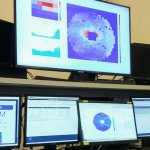Physicists in Italy are about to start up a new experiment designed to hunt for hypothetical particles such as the “dark photon” and carriers of a possible fifth force of nature. The Positron Annihilation into Dark Matter Experiment (PADME), located at the National Institute of Nuclear Physics (INFN) laboratories in Frascati outside Rome, will blast a thin diamond target with energetic positrons and record the mass of any exotic new particles produced in the collisions.
The group at Frascati will mainly target the dark photon, which is a heavy version of the ordinary photon. Predicted by various extensions of the Standard Model, it would interact with both dark matter and ordinary matter. Dark photons are not themselves usually considered to be dark matter, since they would carry relatively little mass and would tend to have decayed earlier in the history of the universe.
Dark photons are also being pursued at experiments in other laboratories, such as CERN in Geneva and the Jefferson Lab in Virginia, US.
Raggi and colleagues plan to start taking data at the end of July and then run the experiment until the end of the year. For most of that time they will use positrons with the maximum energy provided by the linac – 550 MeV – to explore the biggest range of possible dark-photon masses (the highest mass being about 24 MeV). However, for a few weeks they also intend to operate at 283 MeV to maximize the production of particles weighing around 17 MeV.
That is the mass of a new particle that Attila Krasznahorkay at the Hungarian Academy of Sciences’s Institute for Nuclear Research (Atomki) and colleagues claimed in 2015 is generated when beryllium-8 radioactively decays. The Hungarian group made its claim after firing protons at lithium-7 targets and observing that the electrons and positrons created in the subsequent decays had an unusual angular distribution. Jonathan Feng and colleagues at the University of California Irvine then calculated that the particle could be a new type of force-carrying boson.
Researchers of Atomki are involved in the PADME experiment.
More: Physics World
 Magyar
Magyar

